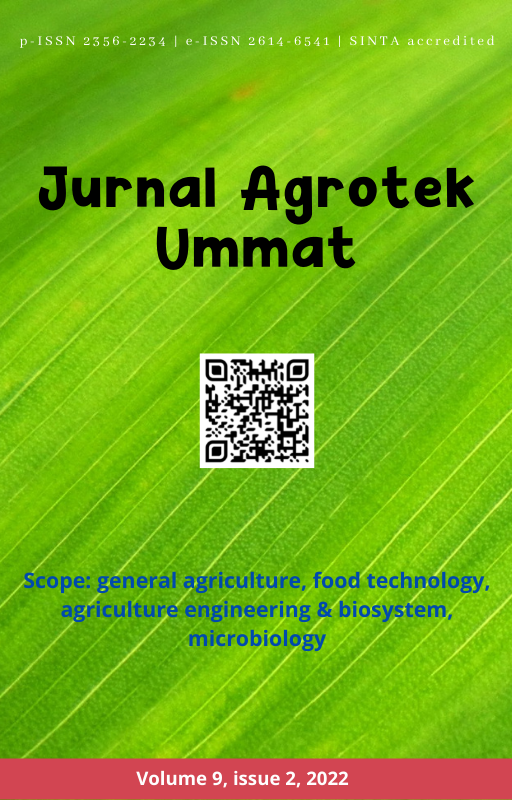Antibacterial activity of Eucheuma cottoni extract and fraction against acne-causing bacteria
DOI:
https://doi.org/10.31764/jau.v9i2.6161Keywords:
antibacterial activity, Eucheuma cottonii, Propionibacterium acnes, Staphylococcus epidermidisAbstract
Acne is a skin disease that often occurs in adolescence and even adulthood, characterized by the presence of blackheads, papules, pustules, nodes, and cysts on the face, neck, upper arms, chest, and back. Although not life-threatening, acne can affect a person's quality of life by giving a bad psychological effect in the way a person assesses, perceives and responds to his condition and situation. The aim of this study is to asses the antibacterial activity of the extract and fraction of the macroalgae Euchema cottonii against acne-causing bacteria, namely Propionibacterium acnes and Staphylococcus epidermidis. The extraction method used was maceration, using 96% p.a ethanol as a solvent and fractionation using the ECC method with three solvents with different polarity levels, namely n-hexane, ethylacetate and ethanol. The activity test was carried out using the paper disc and micro dilution method with the comparison antibacterial clindamycin. The results showed that there was no antibacterial activity from either the extract or fraction of macroalgae Euchema cottonii against the bacteria Propionibacterium acnes, but there are activity from the extract and fraction (n-hexane and ethylacetate) against the Staphylococcus epidermidis bacteria with the MBC value at a concentration of 15% and MIC at a concentration of 5% (for the extract and n-hexane fraction), while for the ethylacetate fraction the MIC value was at a concentration of 10%. Therefor, the strength of the antibacterial activity of the extract and fraction of Eucheuma cottoni is in the weak category.
References
Alfiyaturohmah, Ningsih, R. dan Yusnawan, E. 2014. Uji Aktivitas Antibakteri Ekstrak Kasar Etanol, Kloroform dan N-Heksana Alga Coklat Sargassum vulgare Asal Pantai Kapong Pamekasan Terhadap Bakteri Staphilococcus aureus dan Eschericia coli. ALCHEMY: Journal of Chemistry, 3 (1): 57- 66.
Andriani, Zulli.. Fasya, A.G. dan Hanapi, Ahmad. 2015. Antibacterial Activity of the Red Algae Eucheuma cottonii Extract from Tanjung Coast, Sumenep Madura. ALCHEMY: Journal of Chemistry, Vol. 4 No. 2 hal 93-100
Dermawan, A. M., & PDL, K. (2015). Efektivitas krim anti jerawat ekstrak metanol daun pacar air (Impatiens balsamina L.). Traditional Medicine Journal, 20(3), 127-33.
Lutfiyanti, N., Roza R.M dan martina, A. 2014. Aktivitas Antijamur Senyawa Bioaktif Ekstrak Gelidium latifolium terhadap Candida albicans. Jurnal Pengolahan dan Bioteknologi Hasil Perikanan, 1 (1): 1-8.
Maduriana, I M. dan Sudira, I W. 2009. Skrining dan Uji Aktivitas Antibakteri Beberapa Rumput Laut dari Pantai Batu Bolong Canggu dan Serangan. Buletin Veteriner Udayana, 1 (2): 69-76.
Nurmala, N., Virgiandhy, I. G. N., Andriani, A., & Liana, D. F. (2015). Resistensi dan sensitivitas bakteri terhadap antibiotik di RSU dr. Soedarso Pontianak tahun 2011-2013. eJournal Kedokteran Indonesia.
Suryaningrum, T. D., & Kristiana, H. (2006). Uji aktivitas senyawa antioksidan dari rumput laut Halymenia harveyana dan Eucheuma cottonii. Jurnal Pascapanen dan Bioteknologi Kelautan dan Perikanan, 1(1), 51-64.
Srikong, W., Mittraparp-arthorn, P., Rattanaporn, O., Bovornreungroj, N., & Bovornreungroj, P. (2015). Antimicrobial activity of seaweed extracts from Pattani, Southeast coast of Thailand. Food and Applied Bioscience Journal, 3(1), 39-49.
Wahdaningsih, S., Untari, E.K. dan Fauziah, Y., 2014, Antibakteri Fraksi n-heksana Kulit Hylocereus polyrhizus Terhadap Staphylococcus epidermidis dan Propionibacterium acnes, Pharm Sci Res, 1 (3) : 180-183.
Downloads
Published
Issue
Section
License
Authors who publish articles in Jurnal Agrotek Ummatagree to the following terms:- Authors retain copyright of the article and grant the journal right of first publication with the work simultaneously licensed under a CC-BY-SA or The Creative Commons Attribution–ShareAlike License.
- Authors are able to enter into separate, additional contractual arrangements for the non-exclusive distribution of the journal's published version of the work (e.g., post it to an institutional repository or publish it in a book), with an acknowledgment of its initial publication in this journal.
- Authors are permitted and encouraged to post their work online (e.g., in institutional repositories or on their website) prior to and during the submission process, as it can lead to productive exchanges, as well as earlier and greater citation of published work (See The Effect of Open Access).

